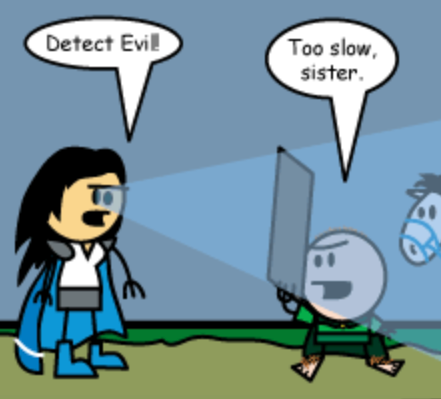
2022-12-26

Worried you might not get your lead sheet out in time? You're playing the wrong game!
The game of Advanced Dungeons & Dragons contains a huge amount of rules you will never learn about unless you read the books or someone teaches you. These rules are awesome, but for better or worse, you cannot play the game without reading the books most of the way through. You cannot reliably extrapolate from other RPGs or even other games bearing the *D&D trademark. It's just not possible. If you attempt this, you will end up playing a different game than AD&D. It might be vaguely similar to AD&D, but it will not be AD&D.
This is something I realized when learning the game, and I was reminded of it this week when someone posted a Reddit thread asking about a paladin going through a city with his "evil sense on."
It's very important to read the DETECTION OF EVIL AND/OR GOOD section on DMG 60. I will reproduce the first few sentences of this three-paragraph section here:
It is important to make a distinction between character alignment and some powerful force of evil or good when this detection function is considered. In general, only a know alignment spell will determine the evil or good a character holds within. It must be a great evil or a strong good to be detected. Characters who are very strongly aligned, do not stray from their faith, and who are of relatively high level (at least 8th or higher) might radiate evil or good if they are intent upon appropriate actions.
Alignment is a topic for another hundred posts, but suffice it to say that evil is a force in AD&D, it's not a morality, and it differs from being aligned with evil. This being the case, to be detected, the evil must be "great." So great, that for a character to emanate evil, they must be:
Additionally, the paladin must be "concentrating on determining the presence of evil and seeking to detect it in the right general direction," which indicates that they require some measure of focus and can't be doing anything else at the time. This is up to some interpretation but I doubt a paladin could walk around a city using this ability. If a DM extrapolates from similar abilities, the DM may even require near-silence to obtain the level of concentration required. I typically do, depending on the level of evil being detected.
Many players I've explained this to were surprised to learn that the ability worked this way. All of the players who have voiced an opinion on the matter indicated that they prefer this system over evil-detection in other systems. I am inclined to agree.
AD&D paladins are awesome and have many impressive powers. Being able to walk around a city and scan for evil-aligned people is not one of them.
Bonus: Observant AD&D rules-readers will note that curses are always neutral, and traps are also neutral unless they are connected to an aligned plane.